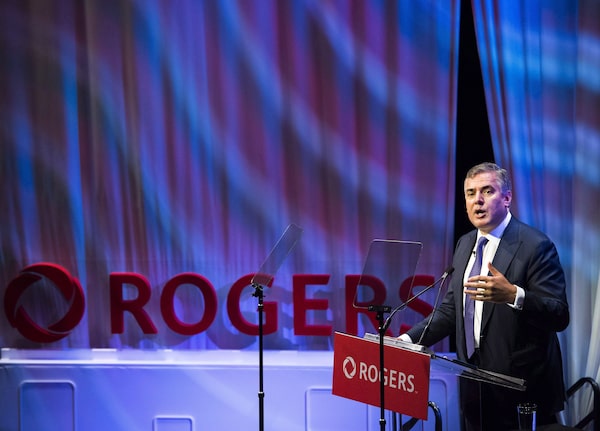
Rogers Communications CEO Joe Natale speaks to shareholders during the Rogers annual general meeting in Toronto on April 20, 2018. Rogers reported $3.58-billion in revenue for the three-month period ended June 30, up 14 per cent from a year ago when it had $3.16-billion in revenue.Nathan Denette/The Canadian Press
Chief executive officer Joe Natale says Rogers Communications Inc . will emerge from the COVID-19 pandemic with a renewed focus on two key objectives: bringing high-speed internet to underserved areas and rolling out 5G wireless technology.
During the onset of the public-health crisis, the company’s engineers worked around the clock to ensure its customers stayed connected, in some cases running fibre-optic cable through parking lots and fields, as data usage surged to new levels.
“There’s nothing more galvanizing to a team than having a very clear and thoughtful mission,” Mr. Natale said in an interview at the company’s Toronto office Wednesday, after Rogers reported higher second-quarter revenue and profit compared with the same period last year.
With the worst of the pandemic’s economic effects now seemingly passing, Mr. Natale is looking to carry that energy and focus into the company’s next mission-critical projects.
“We need to close the digital divide in Canada. There are two million households that have no high speed internet, most of them in rural and remote areas,” Mr. Natale said. “We need to lead in terms of 5G, because the future prosperity and success of Canadian businesses and individuals in the digital economy will rely on it.”
The telecommunications company’s ability to achieve those objectives will be bolstered if regulators approve its proposed merger of Western Canadian cable company Shaw Communications Inc. The deal, valued at $26-billion including debt, would give Rogers access to the extensive fibre-optic infrastructure needed build out its fifth-generation wireless networks in Western Canada.
Early deployments of 5G have relied on adding equipment onto existing wireless networks. But in order to deliver on the promises of the technology – which is expected to power everything from smart manufacturing to autonomous vehicles – telecom companies will need new towers connected to fibre-optic cables.
Two industry sources told The Globe and Mail that Rogers and other telecoms have spent approximately $8-billion combined on 5G airwaves, a hefty sum that some analysts say puts more pressure on the companies to monetize the technology. The Globe is not identifying the sources because they are not authorized to speak publicly. Rogers and other bidders are not allowed to discuss the auction until the results are announced.
Rogers’s acquisition of Shaw could face intense regulatory scrutiny, as it would reduce the number of wireless carriers from four to three in Ontario, Alberta and British Columbia. Some analysts have predicted Rogers will have to part with Shaw’s wireless business in order to gain approval. The deal is being reviewed by the Competition Bureau, the Ministry of Innovation, Science and Economic Development, and the Canadian Radio-television and Telecommunications Commission.
“We feel confident that there’s a resolution here and we’ll be able to complete this transaction,” Mr. Natale said on Wednesday. “We’ve had a very productive and collaborative relationship with government. COVID has brought us together in a remarkable way as we’ve looked to solve the problems of connectivity through the pandemic,” he added.
Rogers reported $3.58-billion in revenue for the three-month period ended June 30, up 14 per cent from a year ago, when it had $3.16-billion in revenue. Its profit for the quarter came to $302-million, up 8 per cent from $279-million during the same period last year. The earnings amounted to 60 cents per diluted share, up from 54 cents per diluted share.
The company also added 99,000 net new postpaid wireless subscribers, 9,000 internet customers and 66,000 subscribers to its internet-based television service, Ignite TV. (Postpaid subscribers are those who are billed at the end of the month for the services they used, versus prepaid customers, who pay upfront for wireless services.)
Its media business, which was hit hard by the pandemic, saw its revenue increase by 84 per cent to $546-million as live sports, which were temporarily halted last year, brought in more television advertising. (Rogers owns the national broadcasting rights to NHL games, the Toronto Blue Jays and part of Maple Leaf Sports and Entertainment. The division also includes television channels such as CITY-TV and radio stations.)
Looking ahead, Mr. Natale sees the resumption of immigration and the easing of lockdown restrictions as key drivers of growth for the sector. Traffic at Rogers stores is up as customers return to shopping malls, looking to check out the latest smartphones.
“What we’re really selling with this device is mobility – the ability to do whatever you would do at home, but do it wherever you happen to be. … We’ll start to see that more front and centre,” Mr. Natale said.
Your time is valuable. Have the Top Business Headlines newsletter conveniently delivered to your inbox in the morning or evening. Sign up today.
 Alexandra Posadzki
Alexandra Posadzki